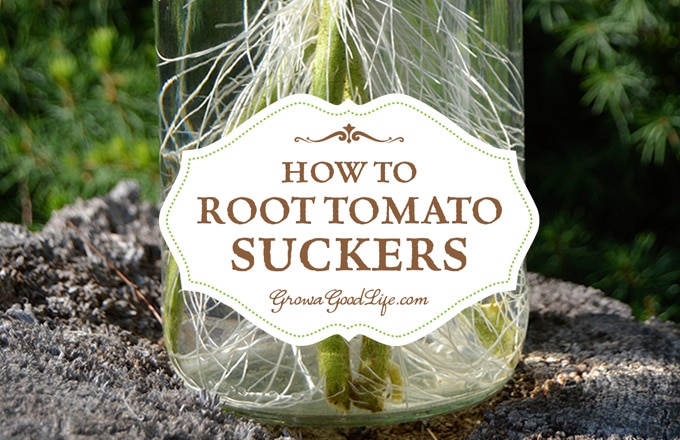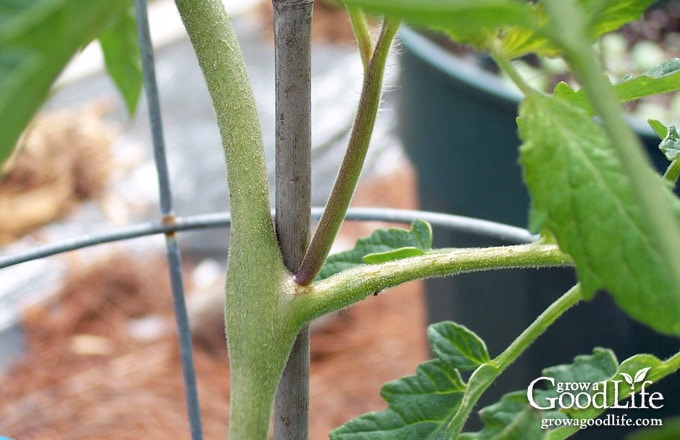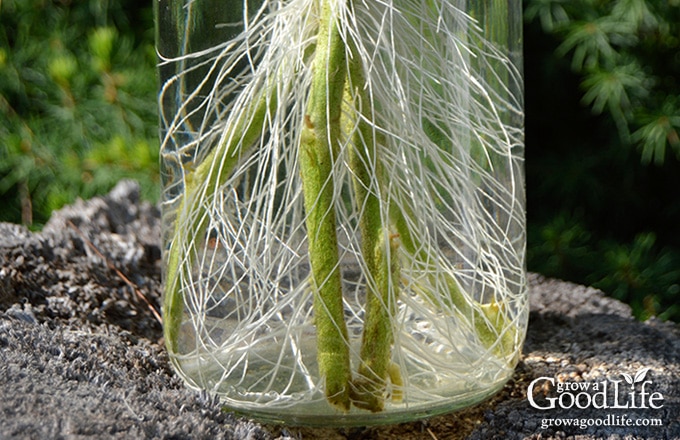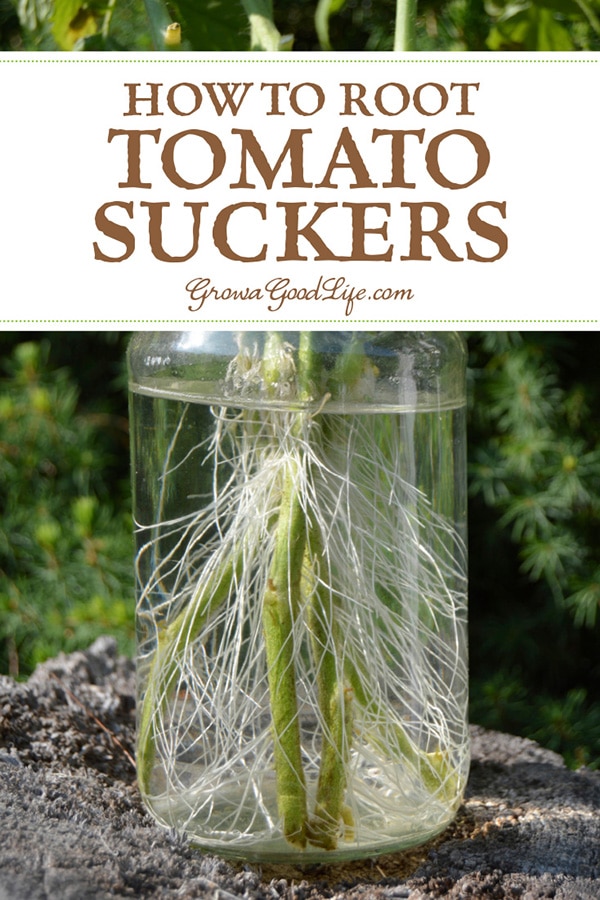How to Root Tomato Suckers and Grow New Plants
This post may contain affiliate links, which means that I may receive a commission if you make a purchase using these links. As an Amazon Associate I earn from qualifying purchases.
Did you know you could root tomato suckers for a second crop of fresh and healthy plants? Cloning tomato plants from suckers is quicker than starting a new crop from seed.

The summer heat and drought conditions can weaken tomato plants and reduce their yield. Instead of coaxing these stressed plants to continue producing and ripening their last fruit, you can root tomato suckers for a second crop of fresh and healthy plants.
The key is to start early, and take cuttings when the plant is still healthy. Within several weeks, you will have new tomato plants. Cloning tomato plants from suckers is quicker than starting a new crop from seed.
What Are Tomato Suckers?
Tomato suckers are the branches that sprout in between the tomato plant’s branches and main stem.

Tomato suckers are the branches that sprout in between the tomato plant’s branches and main stem. Contrary to popular opinion, I don’t prune out all my tomato suckers. I don’t feel it is necessary. The suckers turn into stems that go on to produce blossoms and fruit of their own. Pruning all of these stems reduces the overall yield of the plant.
When I Prune Tomato Suckers
The only time I do prune out suckers is early in the season right when the tomato plants begin to take off. When the plant is about two feet high, I prune the suckers and the leaves at the base of the plant to prevent the foliage from touching the ground and to improve air circulation. Pruning the lower foliage and mulching the plants to prevent soil splash helps to delay the onset of the early blight fungus that is in my soil. By the time the infection begins climbing the plant, most of the tomatoes are harvested and growing season is nearly over.
Instead of tossing the suckers away, I often experiment with rooting them to grow new plants. Since the temperatures are warmer in summer than early spring, the tomato transplants are eager to settle in and begin growing.
Tips for Growing New Tomato Plants from Cuttings
1. Indeterminate tomato plants grow better from cuttings
I have had the best luck with rooting cuttings from indeterminate tomato plants. Indeterminate tomato varieties continue to grow and produce fruit all season.
Stems trimmed from indeterminate varieties root within a week and establish quickly after transplanting.
The determinant tomato plants (also called bush tomatoes) I experimented with rooted, but they did not produce many tomatoes. I recommend trying indeterminate tomato plants for your first attempt to root tomato suckers.
2. Select quick maturing tomato varieties
When propagating tomato plants from stem cuttings, choose varieties that mature quickly so they can produce a crop before your first frost.
Most indeterminate tomato plants need 80-90 days to mature before ripening fruit. Cherry or grape type tomatoes usually produce quicker than other varieties and are a good candidate to experiment with.
3. Take tomato cuttings early in the growing season
Trim the suckers and root the cuttings early in the season when the plant is still vigorous and healthy.
Even though our growing season is short, I have had some good success with the second planting of tomatoes cloned from suckers. I found that if I transplant the rooted cuttings to the garden by the end of June, there is still enough time for them to adapt and begin producing fruit before our first frost in October.
If you live in a warmer climate with a longer growing season, you can take advantage of this method to grow a succession crop of tomatoes well into fall.

Steps to Rooting Tomato Suckers
Choose a dry day to trim or prune your tomato plants so the cut area heals over quickly reducing the chances of disease.
Step 1: Choose healthy tomato suckers
Select healthy shoots at the base of the plant with no signs of disease. Aim for suckers that are around 3-5-inches long. Use clean pruning shears or scissors to snip the sucker branches off the plant.
Step 2: Place the stems in water to grow roots
Remove the lower leaves and immediately place the stems in a jar of warm water to root tomato suckers.
The plants will wilt for the first few days due to the shock of cutting. Keep the jar out of direct sunlight for a few days so the cutting can recover.
Once the leaves look normal, move the jar to a sunny window or return it outside.
Step 3: Change the water frequently
Change the water every few days replacing with warm water so you don’t shock the roots. You should see some roots forming within a week.
Step 4: Transplant the tomato plants
Once the roots are about an inch long, they are ready to be transplanted into larger containers or their permanent location in the garden.
I like to pot them up in containers first so I can care for them more easily as their roots adapt to growing in soil.
Step 5: Pamper the young tomato seedlings
Water the seedlings well after transplanting and keep well watered until the plants begin to grow. Shade the seedlings from the hot summer sun until it adjusts and starts forming new foliage.
Step 6: Transplant the tomato seedlings to the garden
Harden off your tomato seedlings, transplant to their permanent growing location, and provide a trellis or support for the vines to grow on.
Your new tomato plants will grow quickly and may even catch up to the parent plant because of the warmer temperatures.
Rooting tomato suckers and growing new plants is a nifty little way of getting an additional tomato harvest for free.
If you garden in an area with a longer growing season, cloning new plants from stem cuttings is a great way to grow a second crop of healthy tomatoes in the fall when the temperatures are cooler.
This article was originally published on July 27, 2016. It has been updated with additional content.
Rooting tomato suckers and growing new plants is a nifty little way of getting an additional tomato harvest for free. If you garden in an area with a longer growing season, cloning new plants from stem cuttings is a great way to grow a second crop of healthy tomatoes in the fall when the temperatures are cooler.
You May Also Like:
- How to Propagate a Rosemary Plant from Stem Cuttings
- What to Do When Late Blight Strikes Your Tomatoes
- Seasoned Tomato Sauce Recipe for Home Canning
- Grilled Tomato Salsa Recipe
Good planning is key to a successful vegetable garden
Whether you are new to growing your own food or have been growing a vegetable garden for years, you will benefit from some planning each year. You will find everything you need to organize and plan your vegetable garden in my PDF eBook, Grow a Good Life Guide to Planning Your Vegetable Garden.



I have had success saving seeds from store bought tomato’s. I just put them on a cheap napkin to dry. Then plant the seeds in seed starting mix 4 weeks before it is warm enough to be outside. Lots of pleasant surprises.
len, That’s wonderful to hear! Saving seeds from store-bought tomatoes can lead to some delightful surprises, and it sounds like you’ve found a method that works well for you. Thanks for sharing your experience!
Can you clone the stems or does it need to be the suckers?
Tom, You can clone both the stems and the suckers of a tomato plant. Suckers are often used because they are readily available and don’t impact the main plant’s fruit production as much when removed. However, any healthy stem section with leaves can be used for cloning. Just make sure to use a clean cut and follow the same rooting process as you would with suckers.
Oh, I was hoping that you would say what hardiness zones are best to get the most benefits from doing this and growing a second crop in this way. Will this work for the Dayton Ohio Area of the USA?
Samuel, I’m happy that you’re curious about rooting tomato suckers for a second crop. This method is effective in various growing zones, including Dayton, Ohio, which is generally in USDA Hardiness Zone 6. Although I didn’t specify growing zones in the article, I gave some tips based on my zone 5 area, which is quite similar to yours. As previously stated, I’ve had success transplanting the rooted cuttings to the garden by the end of June. This timing gives the plants enough time to adjust and produce fruit before our first frost in October. In Dayton, Ohio, consider the average first frost date, which usually falls in mid to late October. Starting your second crop by the end of June is ideal for aligning with the growing window and ensuring a bountiful harvest.
If you will an aspirin in a glass of warm water ,your suckers will root in a week or so .Just be sure to crush the aspirin up be fore u put in it n warm water Also change the water every 3 days
Chuck, I have actually tried this. I set up two glasses of tomato cuttings, and added a crushed aspirin to one. There was no difference. Both rooted at the same rate. So I would save the aspirin for the medicine cabinet because tomato cuttings root very easily with just water. And yes, change the water frequently (step 3 above).
My mother’s family was the first ones in Rankin County, Mississippi, to grow and sell tomatoes for market.. I learned that valuable lesson of rooting and transplanting suckers and it works great.. There is nothing on earth like a home-grown tomato. I eat so many in the summer that I occasionally will get an ulcer in my mouth from all the acid! They truly are the ‘fruit of the gods’….heavenly red gems that we wait for all year!
the suckers on my plants are small, too small to put in water, will they root if I just plant them in soil??
Sue, They might. Give it a try and let me know.
They should keep growing on the plant real well if you leave them along a bit longer. when they are big enough, cut them off.
Thanks for the tip, Keith!
Use a shot glass. Use a small cup with a few round rocks to make crevices for the suckers.
This is a great tip! Thanks for sharing!
Hi..I live in New Zealand and I have had so many problems with unscrupulous seed sellers and garden centres I have black listed them all …?? I am going to try and grow suckers inside from my present crop and then grow suckers from them?? The idea is to get me over the winter period and have developed plants to put into my greenhouse around early Sept when I will be pretty sure the frosts are over …The variety I am growing is Campari or Tasty Toms (as known in new zealand) or Poppy’s great Taste (apparantly a Tasty Tom alias a Campari ) but under another name….YOU SEE WHAT I MEAN,,,I wish the authorities would stamp down on this but thats what its like here.I grow mine initialy in water till roots appear ..RON
I
Hi, Ron! I have the same idea as yours, so I’m wondering if you managed to achieve your goal! I’m planting the first suckers and I’ll go on till spring.
Baika and Ron, I recently came across this article from my friend Kathi at Oak Hill Homestead: How to Overwinter Your Tomato Plants
Thanks! My plants are doing well and i’ll share my experience in spring!
It is impressing to learn from you on how to substitute tomato seedling growing to tomato sucker branches growing technique.
It does save a lot of time waiting for the seeds to sprout and grow into transplants.
It would be really cool to try putting these in a big pot and moving it indoors under blue and red LED lights. Decent tasting winter tomatoes in your basement? Wow!
Debbie, It is possible especially if you have the right lighting. I experimented once on a windowsill and the plant did go on to produce and ripen a few tomatoes. It probably would have survived even longer if it was in a larger container. (https://growagoodlife.com/windowsill-tomatoes-in-the-winter-it-can-be-done/).
Thank you. I actually tried it and my new plant is producing tomatoes. So awesome.
Chaudette, Woohoo! Thank you for letting me know how this worked for you.
Thanks for the tip. I might try that next year rather than purchasing extra seedlings.